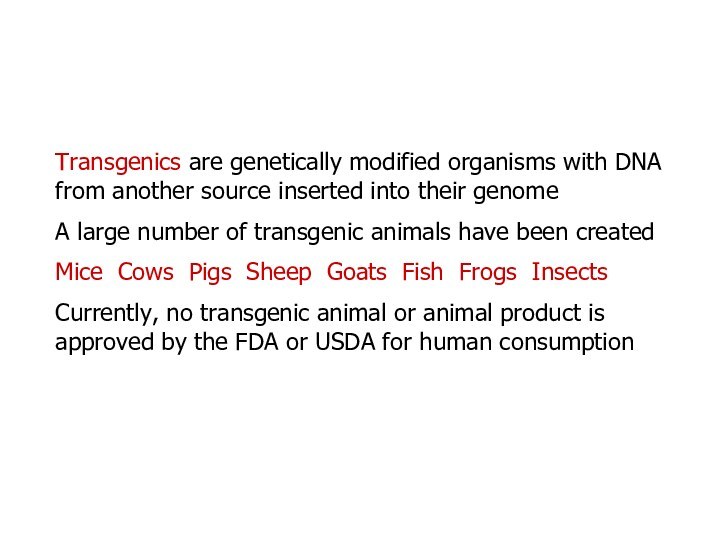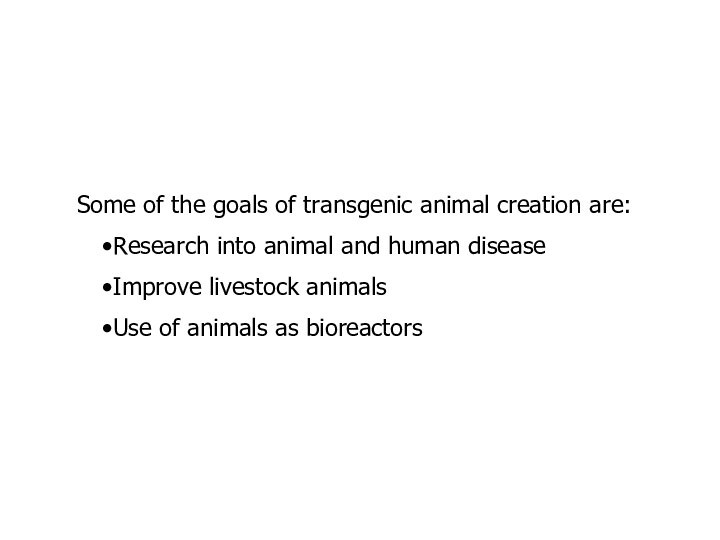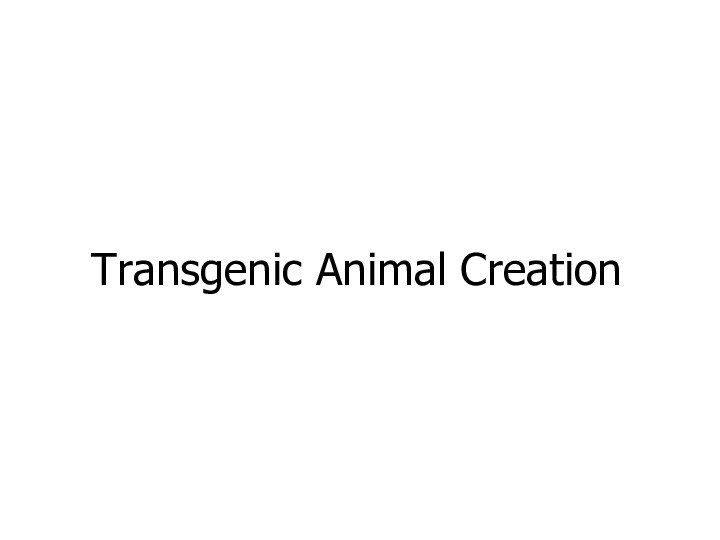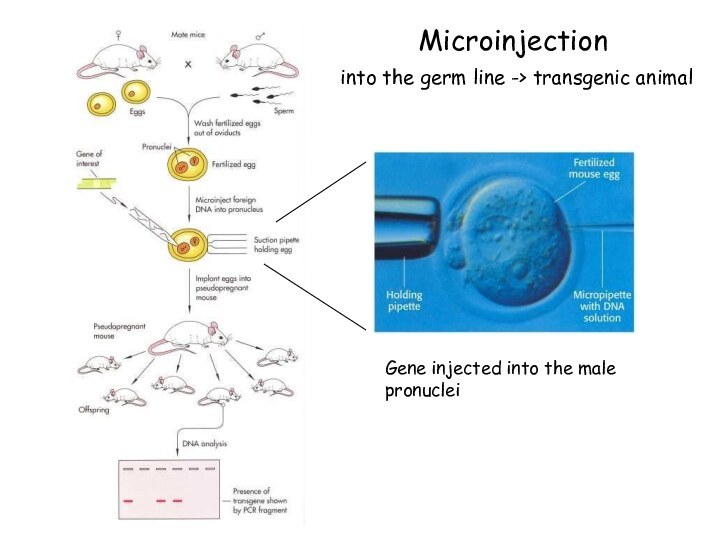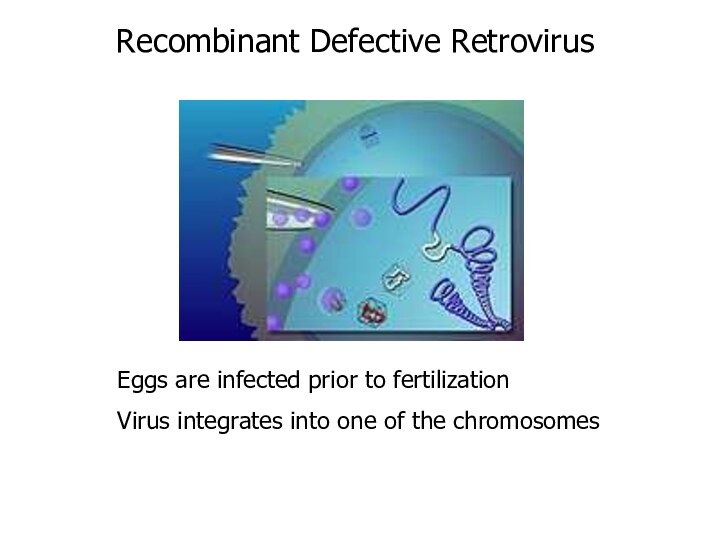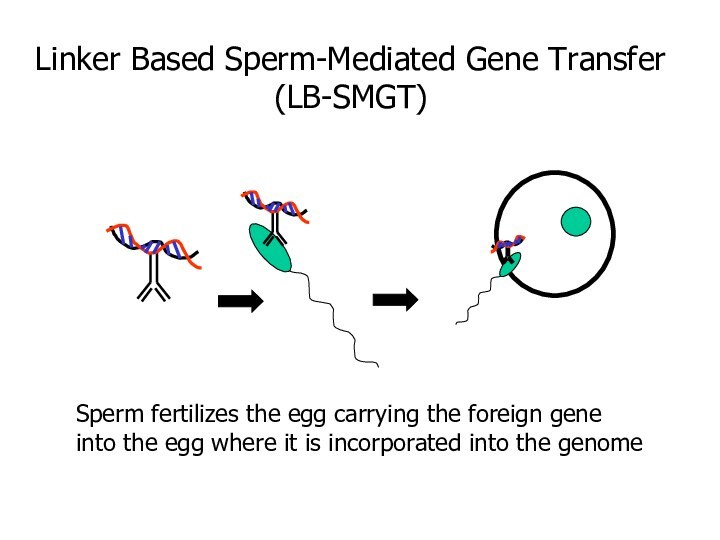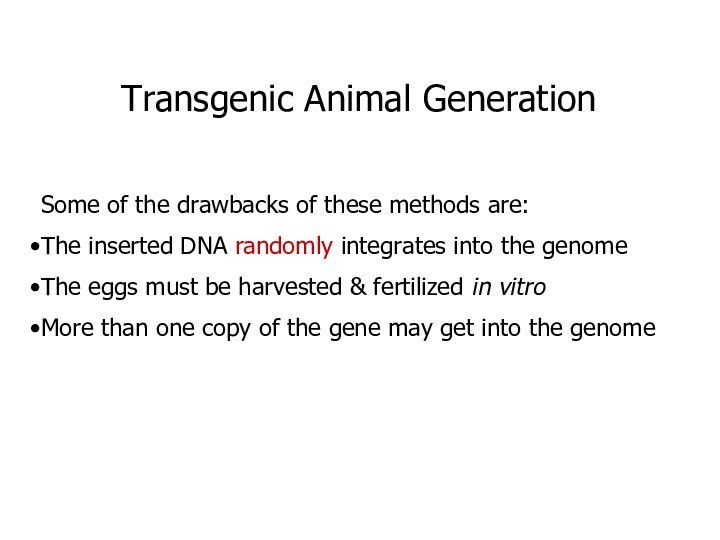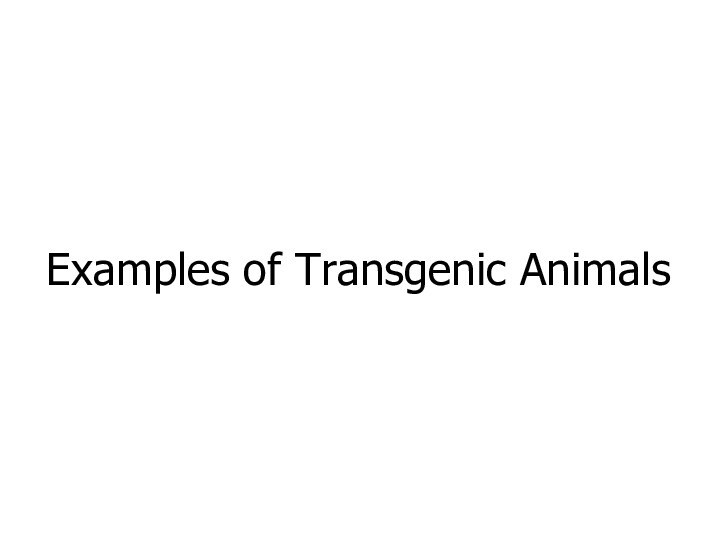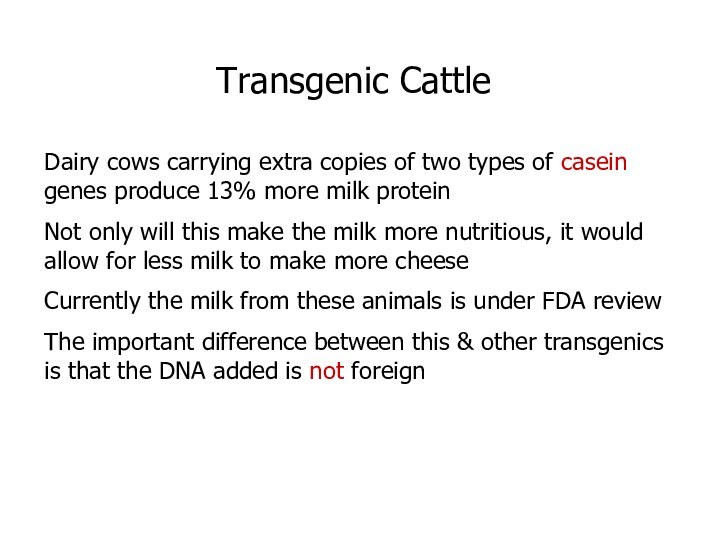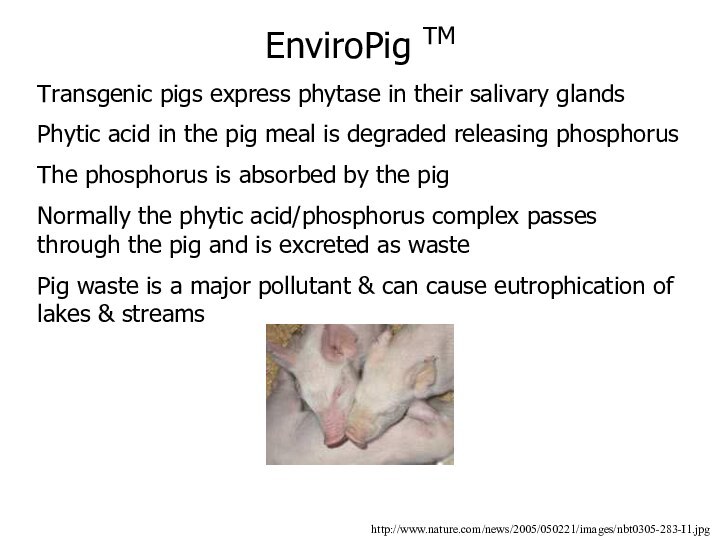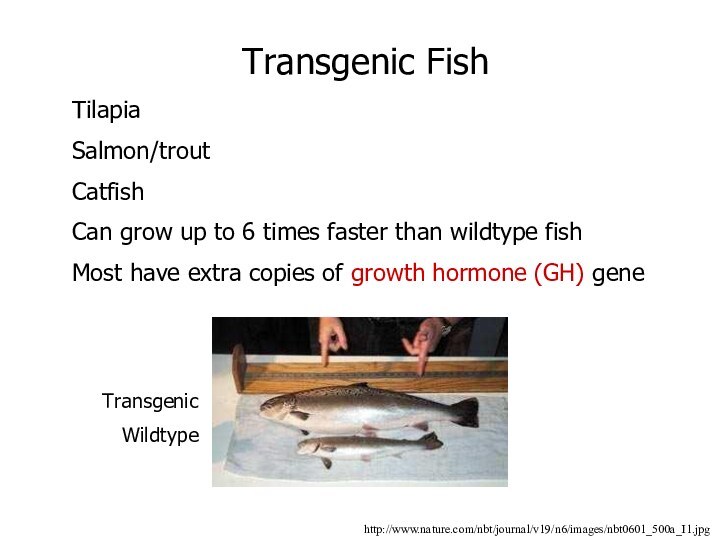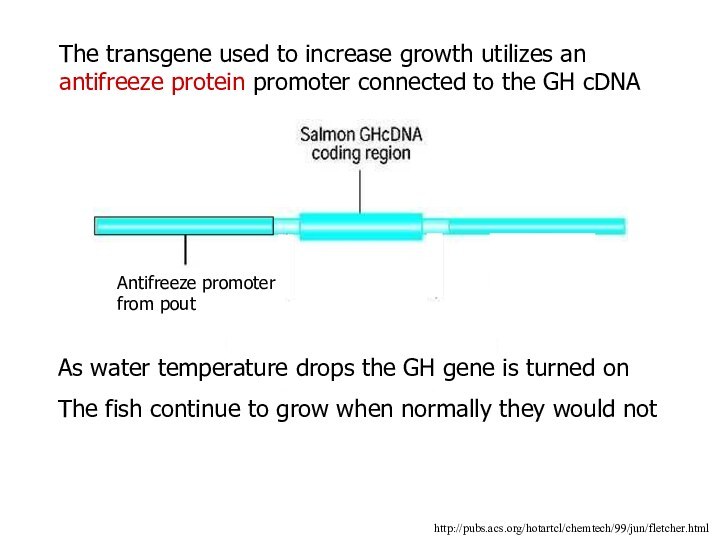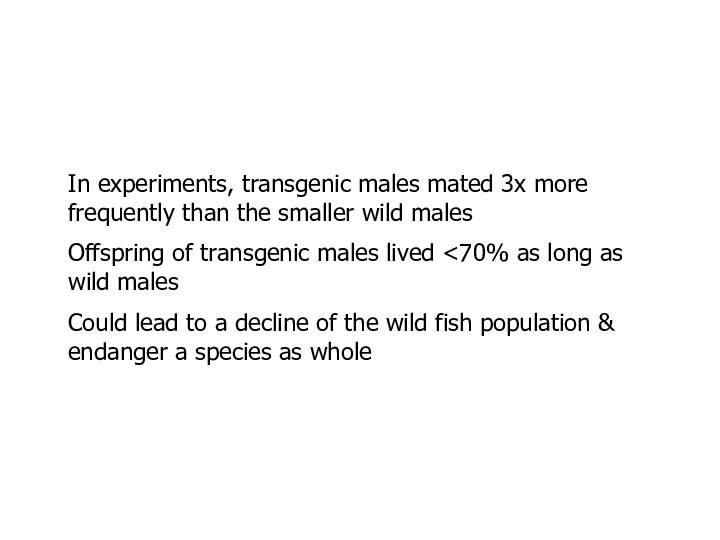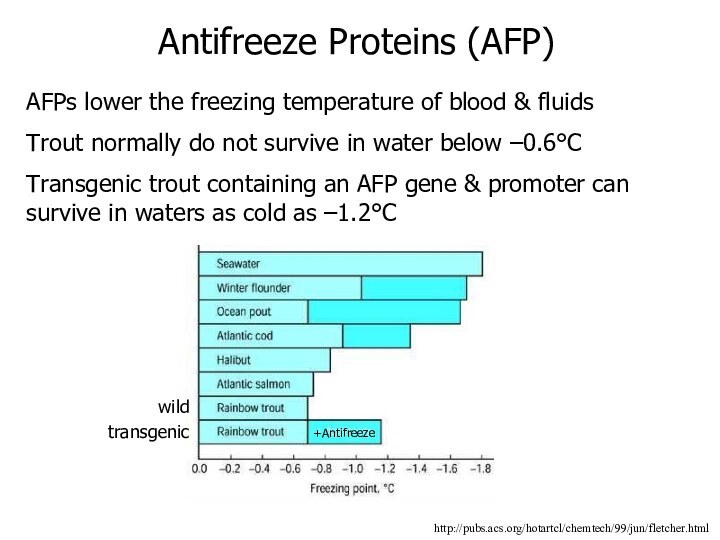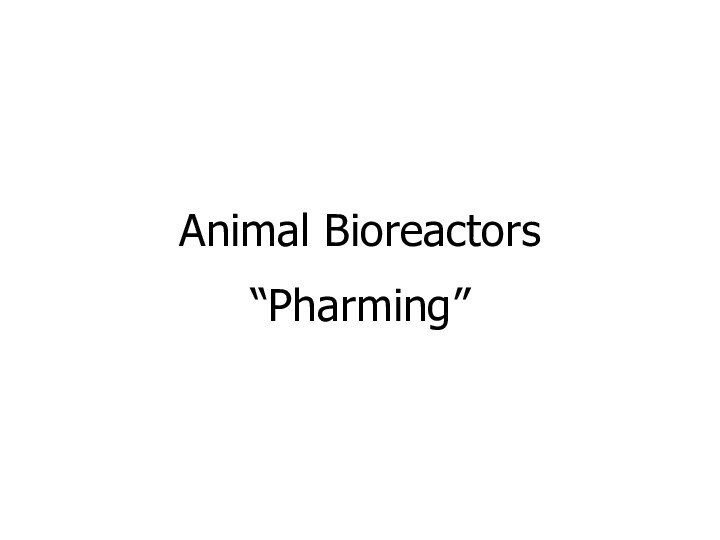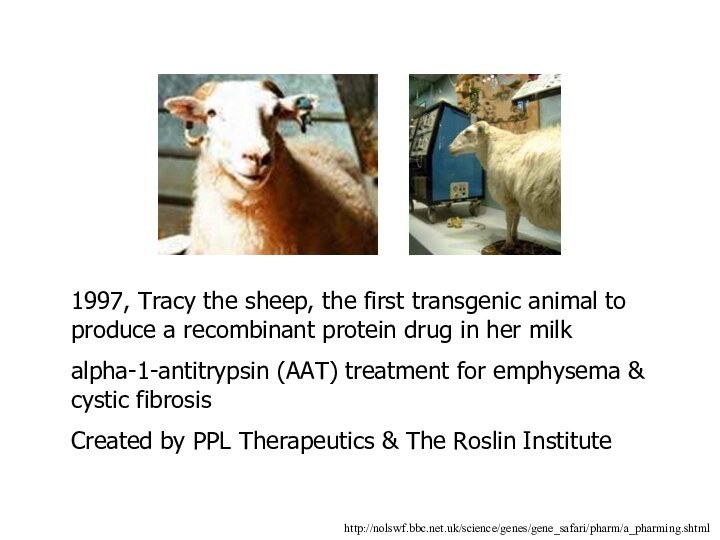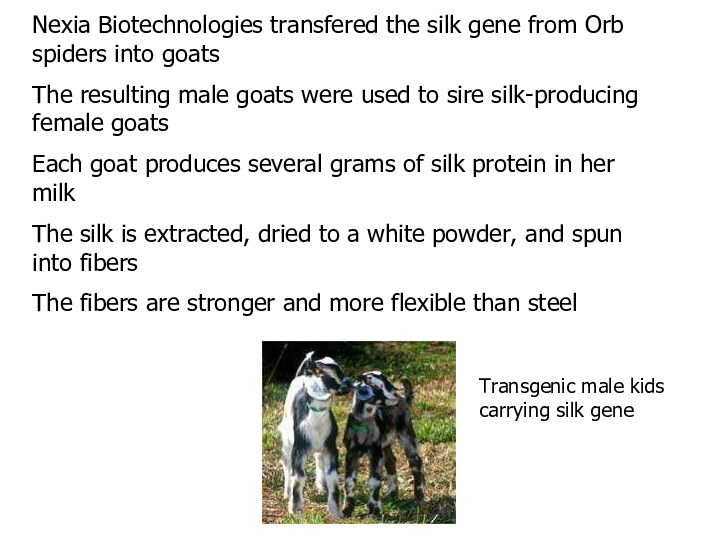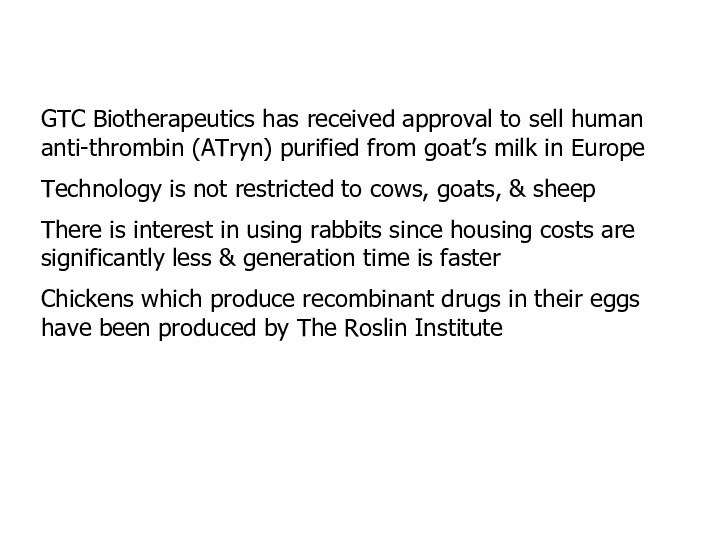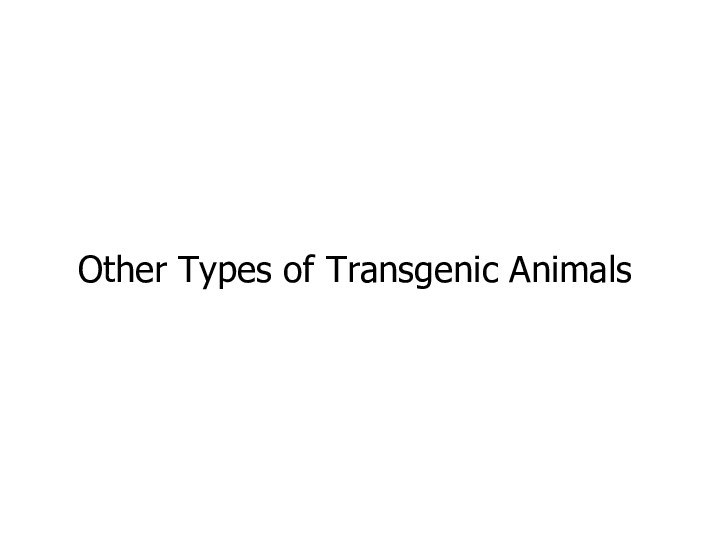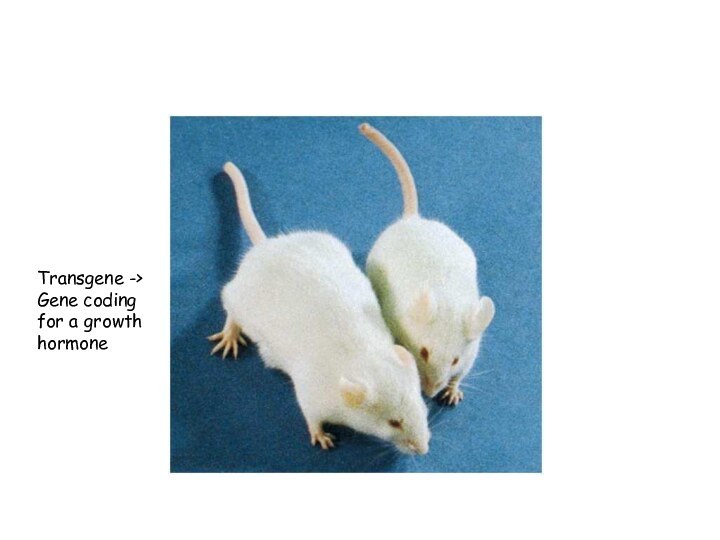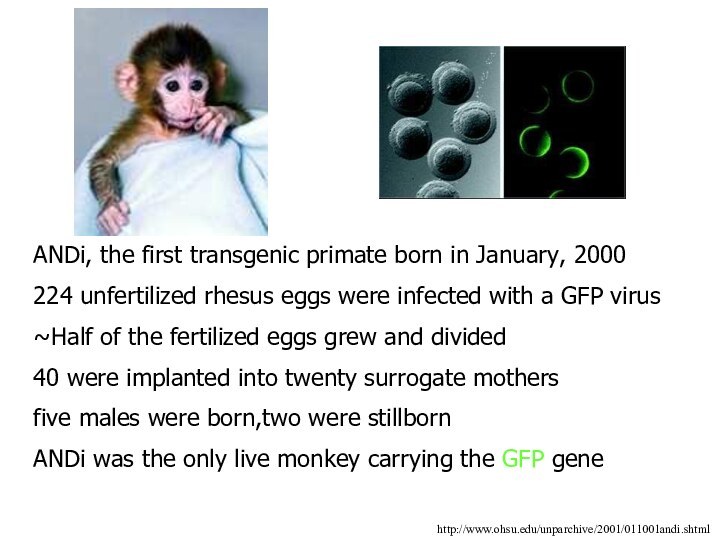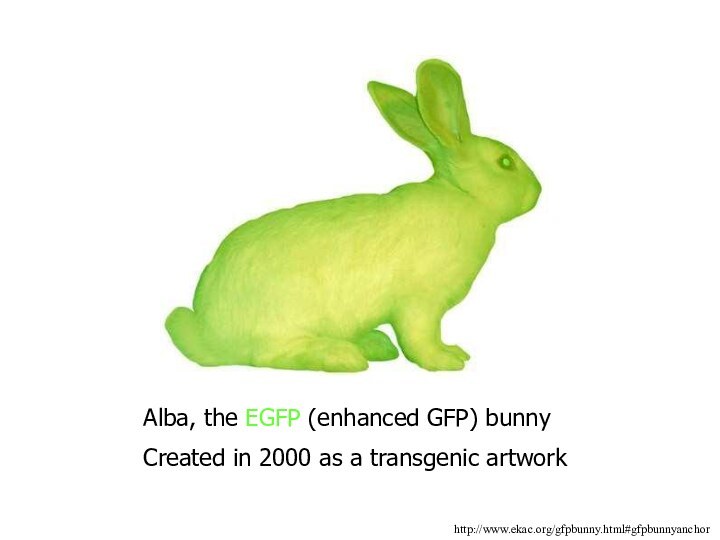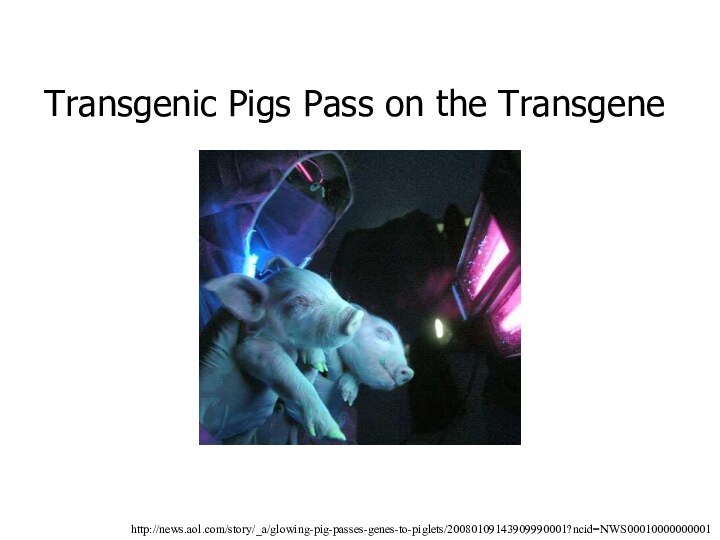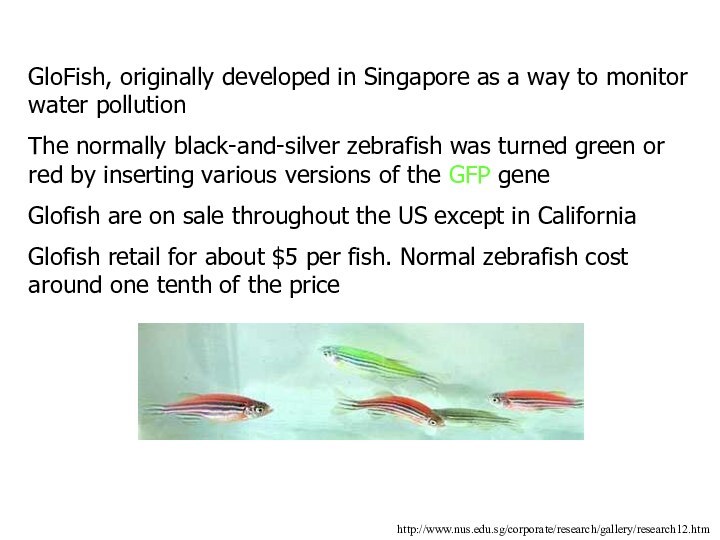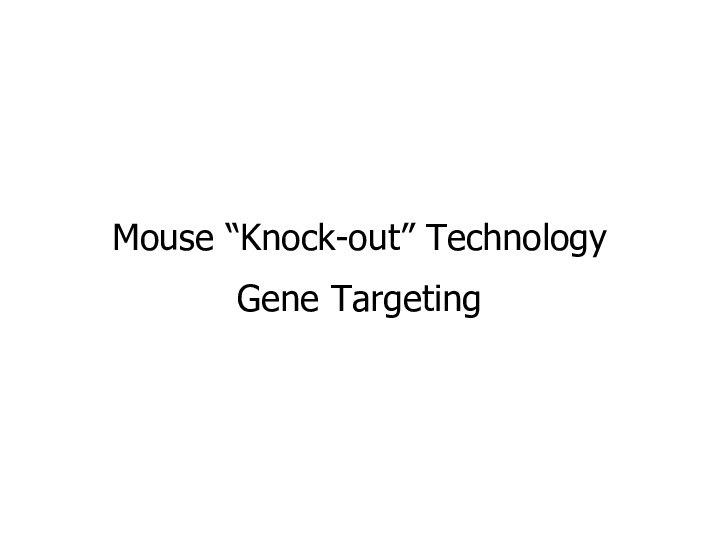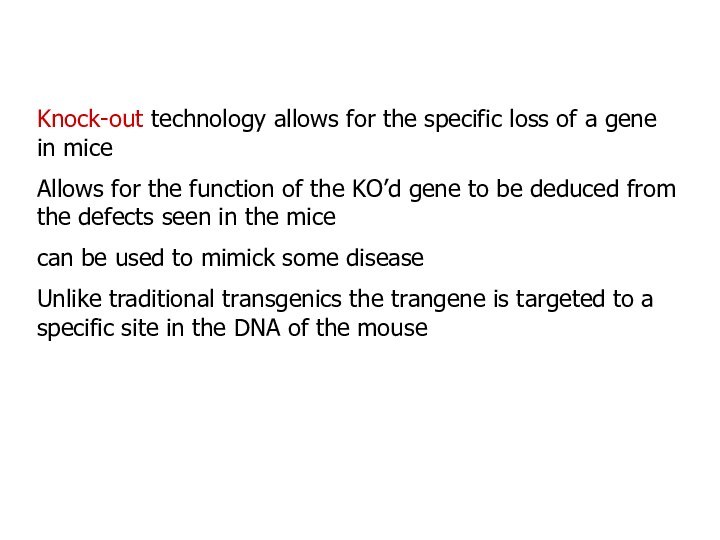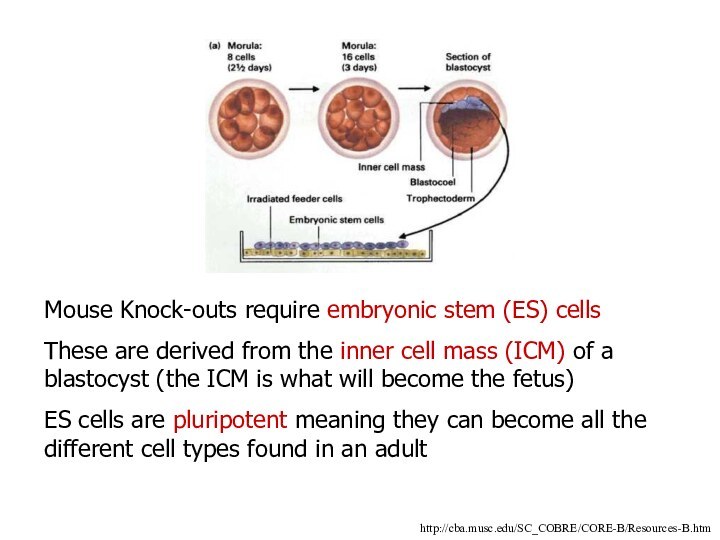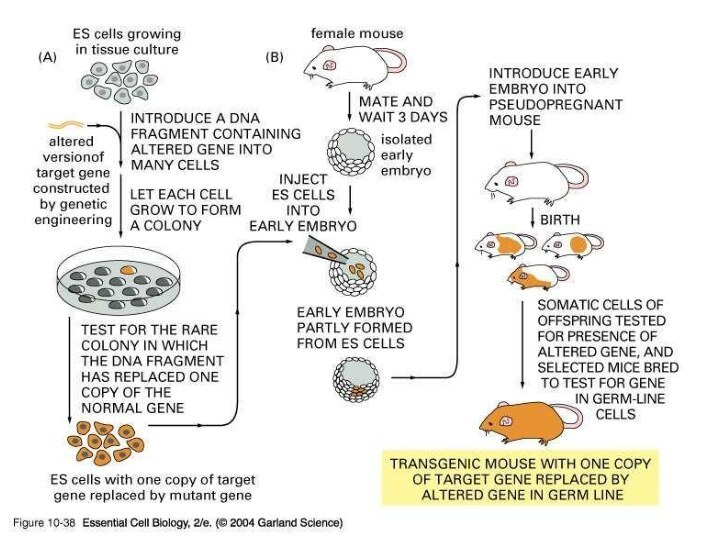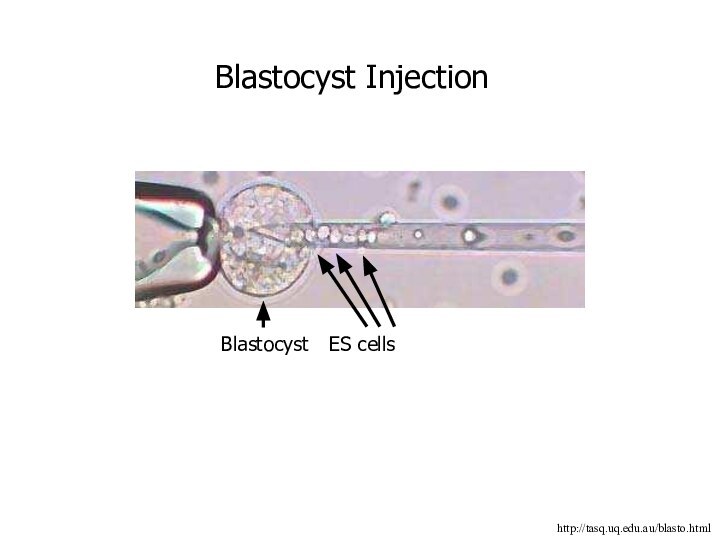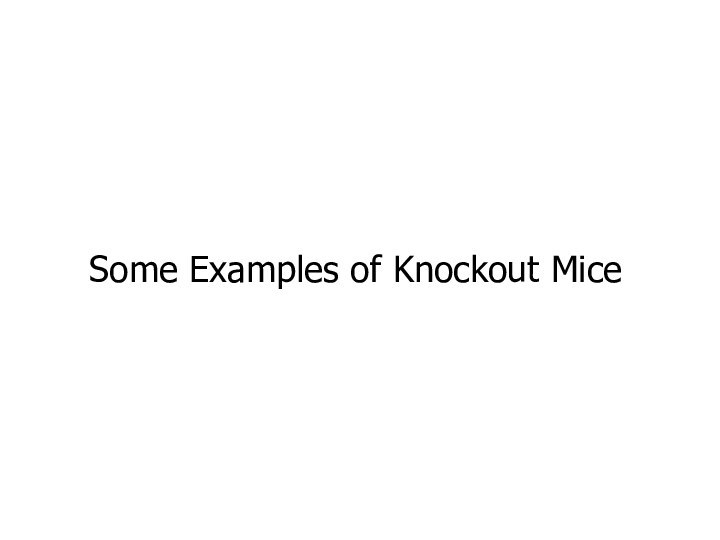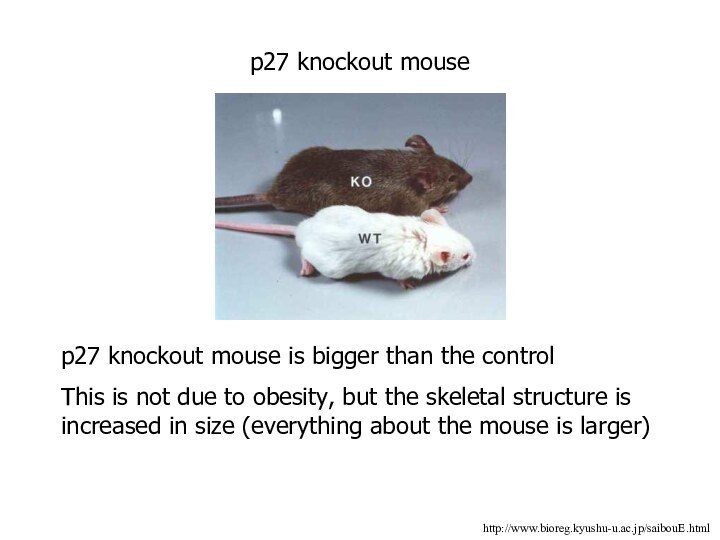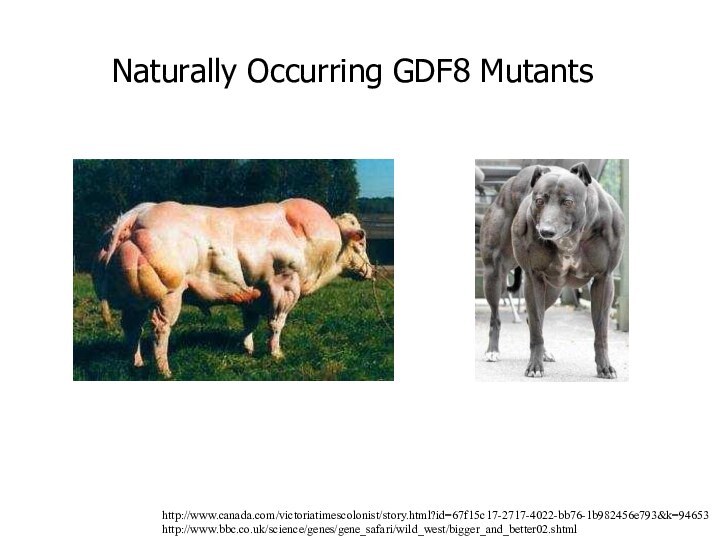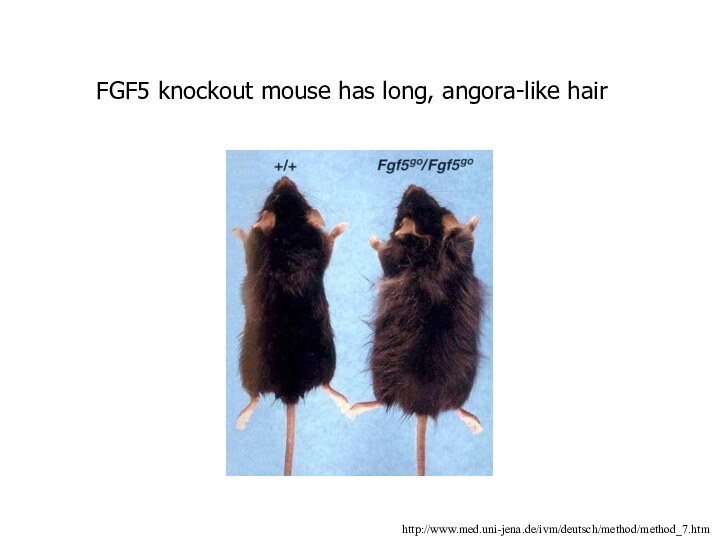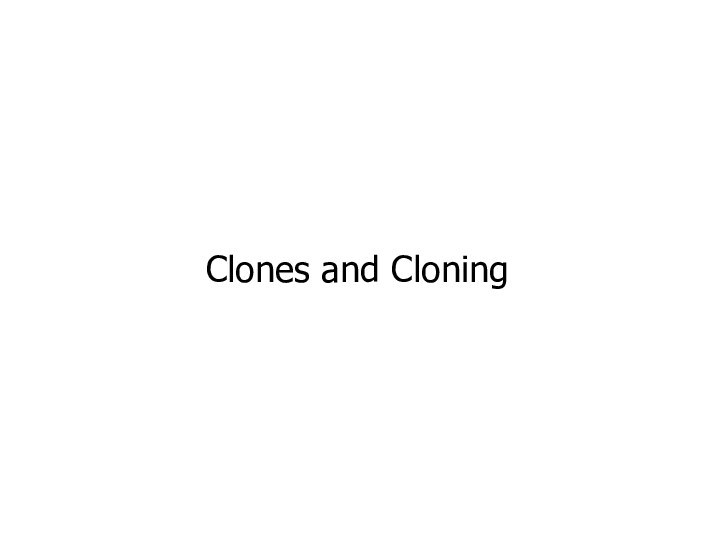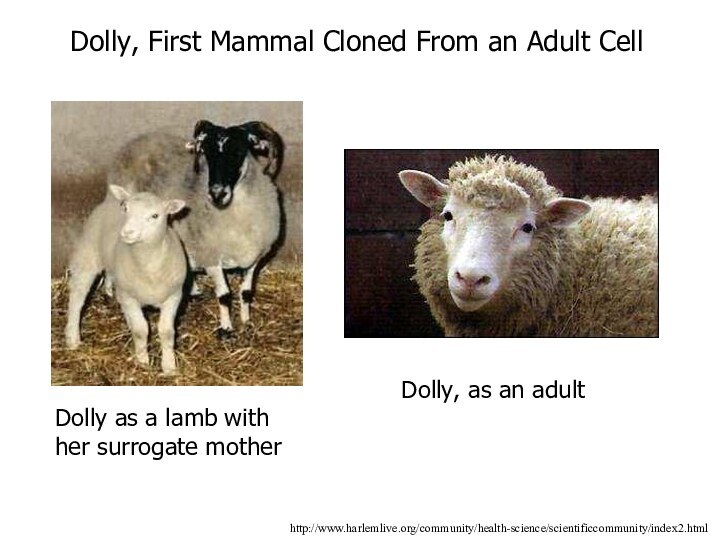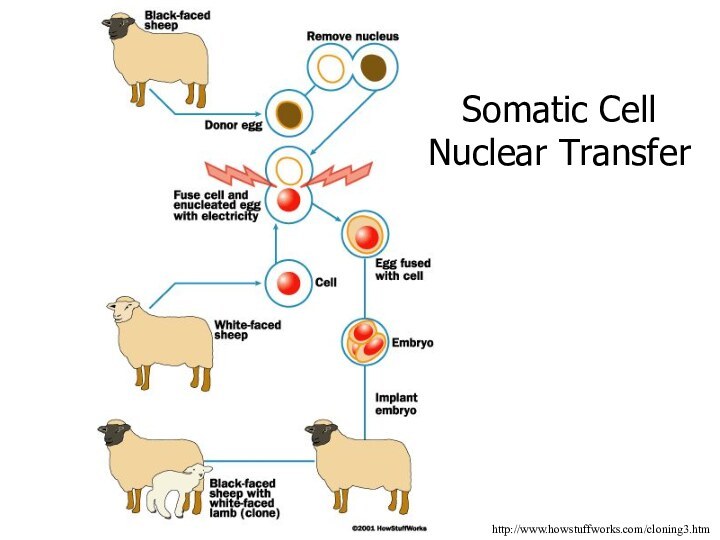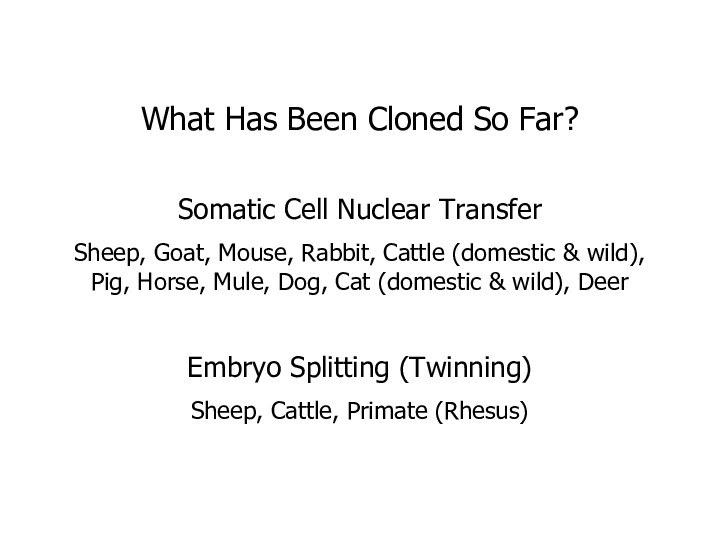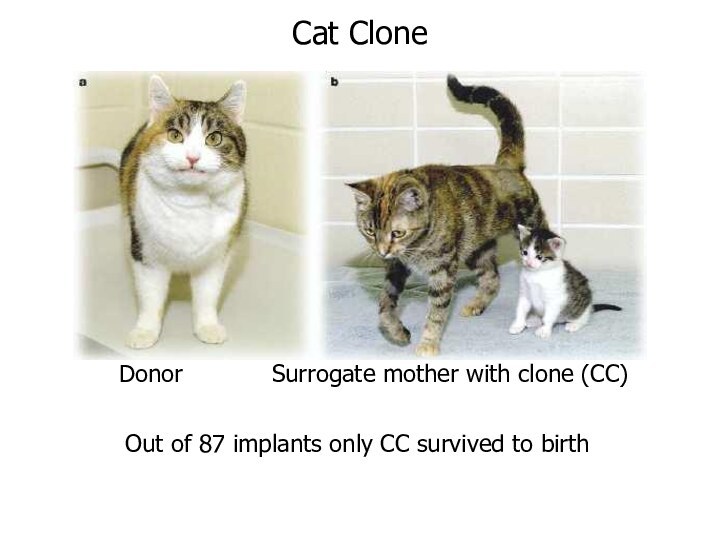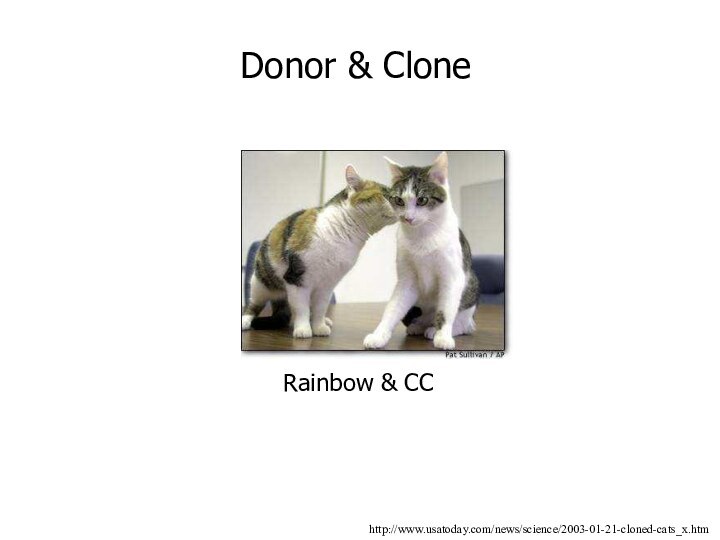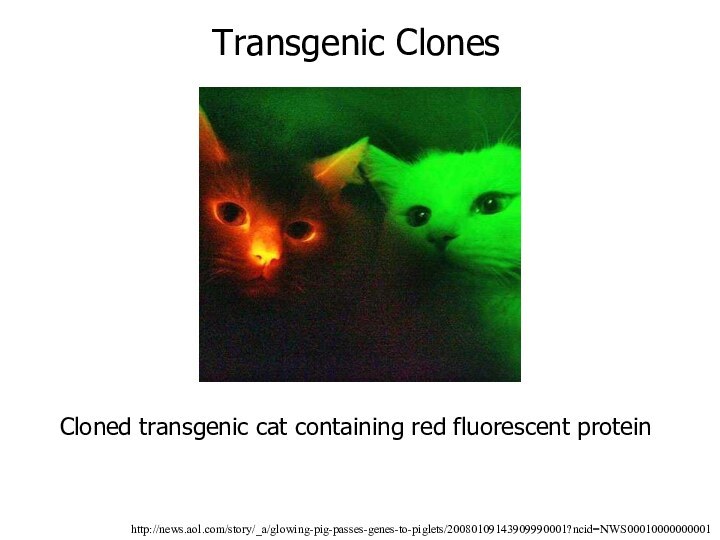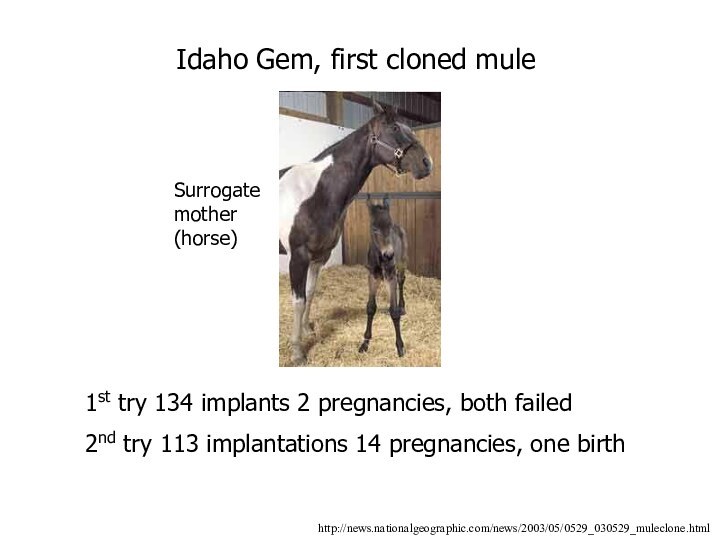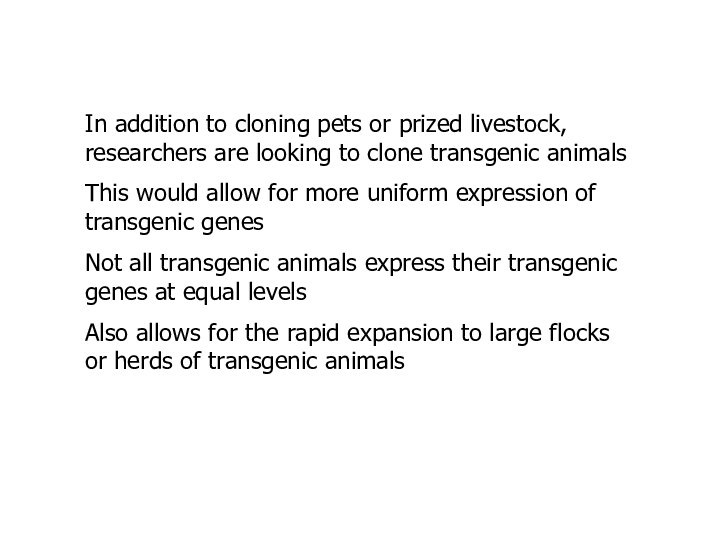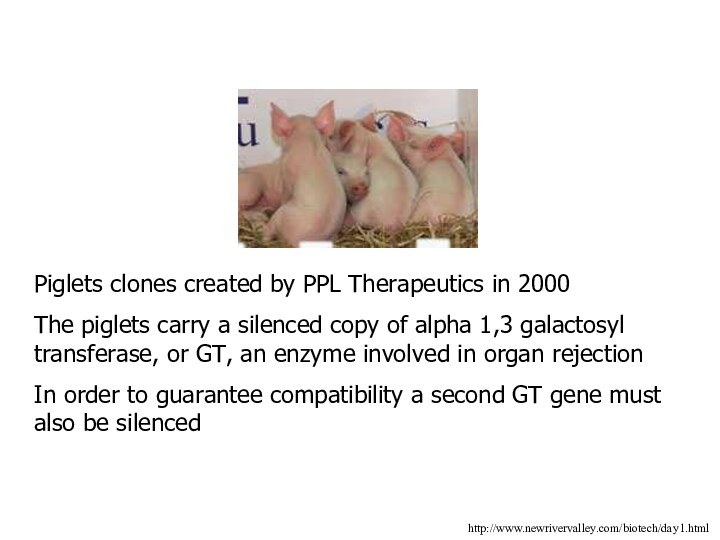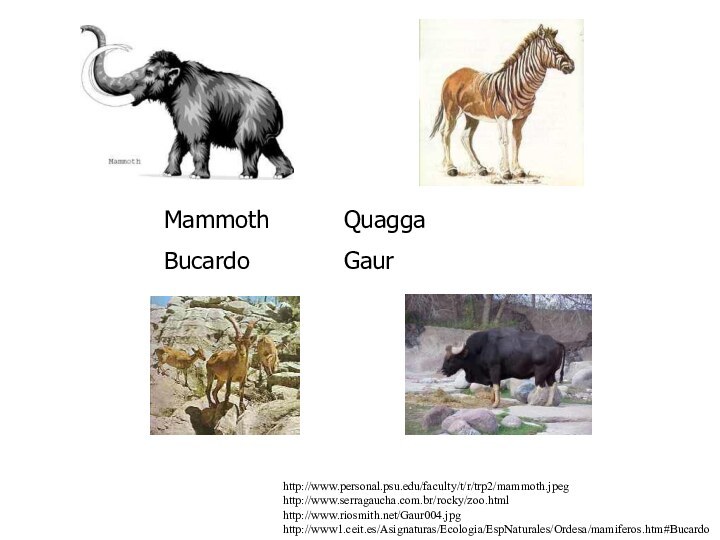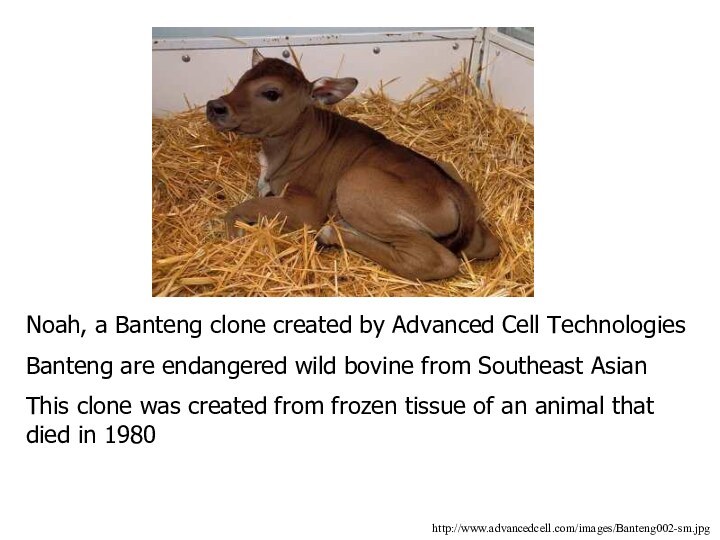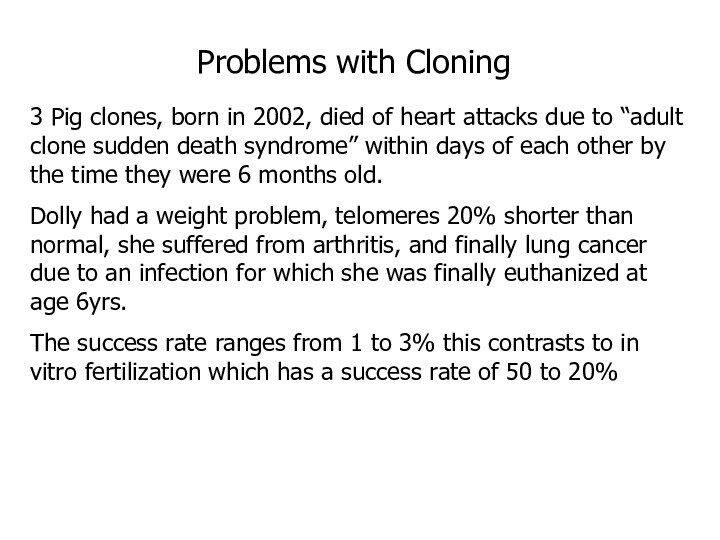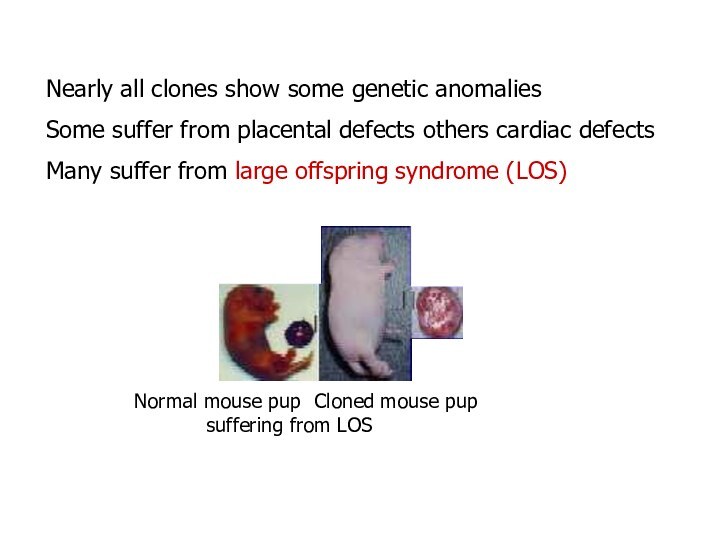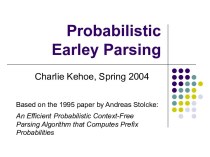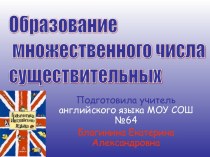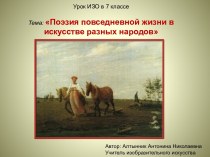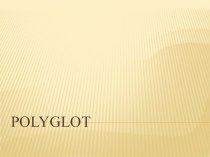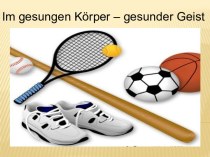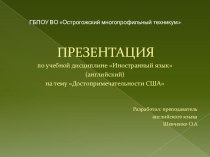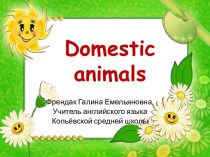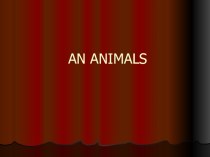Слайд 2
Transgenics are genetically modified organisms with DNA from
another source inserted into their genome
A large number of
transgenic animals have been created
Mice Cows Pigs Sheep Goats Fish Frogs Insects
Currently, no transgenic animal or animal product is approved by the FDA or USDA for human consumption
Слайд 3
Some of the goals of transgenic animal creation
are:
Research into animal and human disease
Improve livestock animals
Use
of animals as bioreactors
Слайд 5
Microinjection
into the germ line -> transgenic
animal
Gene injected into the male pronuclei
Слайд 6
Eggs are infected prior to fertilization
Virus integrates into
one of the chromosomes
Recombinant Defective Retrovirus
Слайд 7
Linker Based Sperm-Mediated Gene Transfer (LB-SMGT)
Sperm fertilizes the
egg carrying the foreign gene into the egg where
it is incorporated into the genome
Слайд 8
Some of the drawbacks of these methods are:
The
inserted DNA randomly integrates into the genome
The eggs must
be harvested & fertilized in vitro
More than one copy of the gene may get into the genome
Transgenic Animal Generation
Слайд 9
Examples of Transgenic Animals
Слайд 10
Transgenic Cattle
Dairy cows carrying extra copies of two
types of casein genes produce 13% more milk protein
Not
only will this make the milk more nutritious, it would allow for less milk to make more cheese
Currently the milk from these animals is under FDA review
The important difference between this & other transgenics is that the DNA added is not foreign
Слайд 11
EnviroPig TM
Transgenic pigs express phytase in their salivary
glands
Phytic acid in the pig meal is degraded releasing
phosphorus
The phosphorus is absorbed by the pig
Normally the phytic acid/phosphorus complex passes through the pig and is excreted as waste
Pig waste is a major pollutant & can cause eutrophication of lakes & streams
http://www.nature.com/news/2005/050221/images/nbt0305-283-I1.jpg
Слайд 12
Transgenic Fish
Tilapia
Salmon/trout
Catfish
Can grow up to 6 times faster
than wildtype fish
Most have extra copies of growth
hormone (GH) gene
Transgenic
Wildtype
http://www.nature.com/nbt/journal/v19/n6/images/nbt0601_500a_I1.jpg
Слайд 13
The transgene used to increase growth utilizes an
antifreeze protein promoter connected to the GH cDNA
http://pubs.acs.org/hotartcl/chemtech/99/jun/fletcher.html
As water
temperature drops the GH gene is turned on
The fish continue to grow when normally they would not
Antifreeze promoter from pout
Слайд 14
Concerns if these ‘supersized’ transgenic fish got loose
Transgenic
fish are farm-raised, isolated from wild stocks
But even during
farming of wildtype fish, escapes happen frequently (~14 million/yr)
What would happen if a large number of transgenic escaped & started breeding with wild fish?
http://pewagbiotech.org/buzz/index.php3?IssueID=10
Слайд 15
In experiments, transgenic males mated 3x more frequently
than the smaller wild males
Offspring of transgenic males lived
<70% as long as wild males
Could lead to a decline of the wild fish population & endanger a species as whole
Слайд 16
http://pubs.acs.org/hotartcl/chemtech/99/jun/fletcher.html
+Antifreeze
wild
transgenic
Antifreeze Proteins (AFP)
AFPs lower the freezing temperature of
blood & fluids
Trout normally do not survive in water
below –0.6°C
Transgenic trout containing an AFP gene & promoter can survive in waters as cold as –1.2°C
Слайд 18
http://nolswf.bbc.net.uk/science/genes/gene_safari/pharm/a_pharming.shtml
1997, Tracy the sheep, the first transgenic animal
to produce a recombinant protein drug in her milk
alpha-1-antitrypsin
(AAT) treatment for emphysema & cystic fibrosis
Created by PPL Therapeutics & The Roslin Institute
Слайд 19
Nexia Biotechnologies transfered the silk gene from Orb
spiders into goats
The resulting male goats were used to
sire silk-producing female goats
Each goat produces several grams of silk protein in her milk
The silk is extracted, dried to a white powder, and spun into fibers
The fibers are stronger and more flexible than steel
Transgenic male kids carrying silk gene
Слайд 20
GTC Biotherapeutics has received approval to sell human
anti-thrombin (ATryn) purified from goat’s milk in Europe
Technology is
not restricted to cows, goats, & sheep
There is interest in using rabbits since housing costs are significantly less & generation time is faster
Chickens which produce recombinant drugs in their eggs have been produced by The Roslin Institute
Слайд 21
Other Types of Transgenic Animals
Слайд 22
Transgene -> Gene coding for a growth hormone
Слайд 23
ANDi, the first transgenic primate born in January,
2000
224 unfertilized rhesus eggs were infected with a GFP
virus
~Half of the fertilized eggs grew and divided
40 were implanted into twenty surrogate mothers
five males were born,two were stillborn
ANDi was the only live monkey carrying the GFP gene
http://www.ohsu.edu/unparchive/2001/011001andi.shtml
Слайд 24
Alba, the EGFP (enhanced GFP) bunny
Created in 2000
as a transgenic artwork
http://www.ekac.org/gfpbunny.html#gfpbunnyanchor
Слайд 25
http://news.aol.com/story/_a/glowing-pig-passes-genes-to-piglets/20080109143909990001?ncid=NWS00010000000001
Transgenic Pigs Pass on the Transgene
Слайд 26
GloFish, originally developed in Singapore as a way
to monitor water pollution
The normally black-and-silver zebrafish was
turned green or red by inserting various versions of the GFP gene
Glofish are on sale throughout the US except in California
Glofish retail for about $5 per fish. Normal zebrafish cost around one tenth of the price
http://www.nus.edu.sg/corporate/research/gallery/research12.htm
Слайд 27
Mouse “Knock-out” Technology
Gene Targeting
Слайд 28
Knock-out technology allows for the specific loss of
a gene in mice
Allows for the function of the
KO’d gene to be deduced from the defects seen in the mice
can be used to mimick some disease
Unlike traditional transgenics the trangene is targeted to a specific site in the DNA of the mouse
Слайд 29
http://cba.musc.edu/SC_COBRE/CORE-B/Resources-B.htm
Mouse Knock-outs require embryonic stem (ES) cells
These
are derived from the inner cell mass (ICM) of
a blastocyst (the ICM is what will become the fetus)
ES cells are pluripotent meaning they can become all the different cell types found in an adult
Слайд 31
http://tasq.uq.edu.au/blasto.html
Blastocyst Injection
Blastocyst ES cells
Слайд 32
http://bunseiserver.pharm.hokudai.ac.jp/gihou/knockout.html
Chimeric mouse
The brown fur comes from ES cells
injected into the blastocyst of an albino mouse
Слайд 34
p27 knockout mouse is bigger than the control
This
is not due to obesity, but the skeletal structure
is increased in size (everything about the mouse is larger)
http://www.bioreg.kyushu-u.ac.jp/saibouE.html
p27 knockout mouse
Слайд 35
http://www.bbc.co.uk/science/genes/gene_safari/wild_west/bigger_and_better02.shtml
GDF8 (Myostatin) knockout mouse
Over twice the muscle mass
of a wildtype mouse
normal knockout
Слайд 36
Naturally Occurring GDF8 Mutants
http://www.canada.com/victoriatimescolonist/story.html?id=67f15c17-2717-4022-bb76-1b982456e793&k=94653
http://www.bbc.co.uk/science/genes/gene_safari/wild_west/bigger_and_better02.shtml
Слайд 37
FGF5 knockout mouse has long, angora-like hair
http://www.med.uni-jena.de/ivm/deutsch/method/method_7.htm
Слайд 39
http://www.harlemlive.org/community/health-science/scientificcommunity/index2.html
Dolly as a lamb with her surrogate mother
Dolly,
First Mammal Cloned From an Adult Cell
Dolly, as an
adult
Слайд 40
http://www.howstuffworks.com/cloning3.htm
Somatic Cell Nuclear Transfer
Слайд 41
What Has Been Cloned So Far?
Somatic Cell Nuclear
Transfer
Sheep, Goat, Mouse, Rabbit, Cattle (domestic & wild), Pig,
Horse, Mule, Dog, Cat (domestic & wild), Deer
Embryo Splitting (Twinning)
Sheep, Cattle, Primate (Rhesus)
Слайд 42
Cat Clone
Donor Surrogate mother with clone
(CC)
Out of 87 implants only CC survived to birth
Слайд 43
http://www.usatoday.com/news/science/2003-01-21-cloned-cats_x.htm
Donor & Clone
Rainbow & CC
Слайд 44
Cloned transgenic cat containing red fluorescent protein
http://news.aol.com/story/_a/glowing-pig-passes-genes-to-piglets/20080109143909990001?ncid=NWS00010000000001
Transgenic Clones
Слайд 45
http://news.nationalgeographic.com/news/2003/05/0529_030529_muleclone.html
Idaho Gem, first cloned mule
1st try 134 implants
2 pregnancies, both failed
2nd try 113 implantations 14 pregnancies,
one birth
Surrogate mother (horse)
Слайд 46
In addition to cloning pets or prized livestock,
researchers are looking to clone transgenic animals
This would allow
for more uniform expression of transgenic genes
Not all transgenic animals express their transgenic genes at equal levels
Also allows for the rapid expansion to large flocks or herds of transgenic animals
Слайд 47
http://www.newrivervalley.com/biotech/day1.html
Piglets clones created by PPL Therapeutics in 2000
The
piglets carry a silenced copy of alpha 1,3 galactosyl
transferase, or GT, an enzyme involved in organ rejection
In order to guarantee compatibility a second GT gene must also be silenced
Слайд 48
Conservation Cloning
Many endangered or extinct animals are being
cloned or considered for cloning
Gaur
Bucardo mountain goat
Mammoth
Quagga
Banteng
Слайд 49
Mammoth Quagga
Bucardo Gaur
http://www.personal.psu.edu/faculty/t/r/trp2/mammoth.jpeg
http://www.serragaucha.com.br/rocky/zoo.html
http://www.riosmith.net/Gaur004.jpg
http://www1.ceit.es/Asignaturas/Ecologia/EspNaturales/Ordesa/mamiferos.htm#Bucardo
Слайд 50
http://www.advancedcell.com/images/Banteng002-sm.jpg
Noah, a Banteng clone created by Advanced Cell
Technologies
Banteng are endangered wild bovine from Southeast Asian
This clone
was created from frozen tissue of an animal that died in 1980
Слайд 51
3 Pig clones, born in 2002, died of
heart attacks due to “adult clone sudden death syndrome”
within days of each other by the time they were 6 months old.
Dolly had a weight problem, telomeres 20% shorter than normal, she suffered from arthritis, and finally lung cancer due to an infection for which she was finally euthanized at age 6yrs.
The success rate ranges from 1 to 3% this contrasts to in vitro fertilization which has a success rate of 50 to 20%
Problems with Cloning
Слайд 52
http://fig.cox.miami.edu/~cmallery/150/gene/cloning.success.jpg

